Nano aquarium fans often rush to add bumblebee gobies (Brachygobius spp.) to their list of desired species. Who wouldn’t?

These colorful little fish add a nice pop of color to the bottom of the tank, and gobies always add interest.
As you might guess from the name, bumblebees carry black stripes that alternate with yellow or orange streaks.
And the color scheme is plastered on the typical “little head-slender body” frame you expect from a goby. It’s a unique pattern.
And, of course, you get the usual adaptation of the abdominal fins. Gobies evolved those fins into a kind of “sucker disc.” This disc allows them to stay in place on surfaces as they move along the bottom in their natural environment.
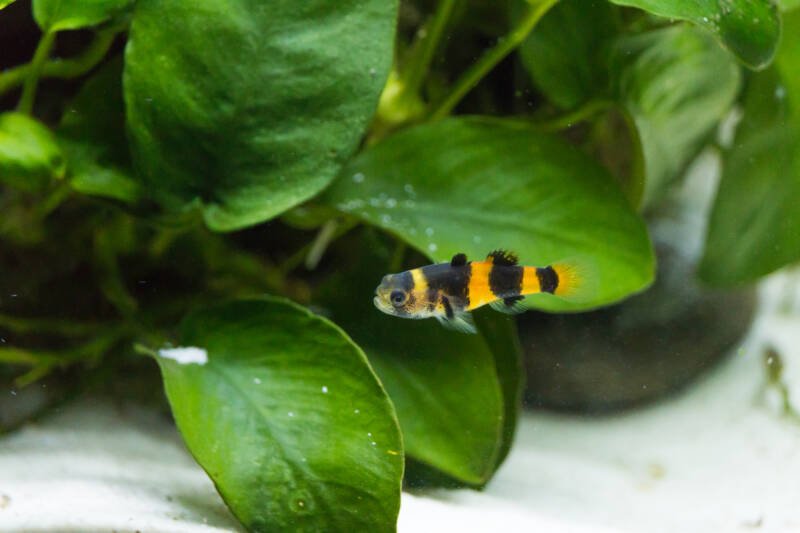
But bumblebee gobies have a few management needs that make them tricky for novices. And if you haven’t prepared, your little bumblebees could end up stressed, ill, and dead in a short period.
Though they’re on the small side, they’re NOT the easiest goby to manage.
At a Glance
- Tank Size: 10 gallons (37 l)
- School Size: 6-7
- Temperature: 72-84F (22-29 C)
- pH: 7.0-8.5
- Hardness: 9-19 dH
- Salinity: 1.002-1.006
- Ammonia: 0 ppm
- Nitrite: 0 ppm
- Nitrate: < 25 ppm
- Lifespan: 3 years
- Size: 1.5 inches (3.8 cm)
In this article
In the Wild
Bumblebee gobies swim in the mangroves and estuaries of Borneo, Java, Indonesia, Sumatra, Thailand, and Vietnam.
That’s right – these tiny gobies prefer brackish water. They tolerate salt levels anywhere between freshwater to slightly below the ocean itself.
Along the bottom, bumblebees encounter clay, sand, and mud. The substrate often has a thick leaf-litter, with mangrove roots and other snags. It can make for blackwater conditions, particularly those fish that move further inland to the peat bogs.
Bumblebees are hardy enough to handle the salt, combined with low acidity and harder waters.
Hanging out in loose shoals, they dart from hiding place to hiding place in their constant search for food. It’s a picture you’ll want to keep in mind when you start building your tank.
Size: Nano Aquarium Residents

Aquarists love bumblebee gobies for their vibrant colors and their size. In the wild, these fish rarely get longer than 1.7 inches (4.3 cm).
However, when you move them into a tank, they come up a bit shorter – around 1.5 inches (3.8 cm). It makes them perfect for nano aquariums.
Lifespan
Bumblebee gobies require a lot of specialized care – something most novice aquarists often struggle with. As such, you can expect to see them live around three years (and that’s with proper care; without it, they don’t last very long).
If you want to stretch your bumblebees out to four years, considering offering them an upgrade.
Several professionals have noted that when they gave their gobies a little more “elbow room,” they lived longer. It’s something to consider.
Behavior

You’d be hard-pressed to find a more sweet-tempered fish than the bumblebee goby.
Similar to their namesake, they’re content to rove around the bottom of an aquarium without harassing anyone (assuming bumblebees could swim, anyway).
They don’t return to a hive at the end of the day, but they’re every bit as social as your average bee. A shoal of at least six fish makes them feel safe and secure.
They don’t always swim in synchronous patterns, but they’ll group together at different points in the day.
You CAN see an occasional squabble. This usually crops up when you don’t provide enough room for the school. The fights aren’t long-lived, and the bumblebees don’t end up injured as a result. But if you increase the aquarium size, you’ll prevent territorial behavior.
Tank Setup
Even if you go for a school of seven bumblebee gobies, you can get away with a standard nano aquarium of 10 gallons (38 l).
You want to make sure everyone has room to explore and scout for food without feeling crowded, but it’s a size that works for these tiny gobies.
While all gobies have the adaptation of the sucker disc, it isn’t particularly strong. And they’re not the best swimmers. As such, you want to minimize the water current in your tank. The outflow from your filter is all you need.
Water Conditions
Bumblebee gobies tolerate a wide range of salinities. And breeders take advantage of that fact.
Before you leap at the chance to start your first brackish tank, talk with the breeder. You want to make sure you match the water conditions they used.
Very rarely, some bumblebees end up raised in freshwater. If they tolerated the absence of salt, you need to continue those conditions to prevent shock.
The flip side is also true: you can’t drop a brackish goby into a freshwater tank without causing stress and death.
In general, one teaspoon of marine salt per gallon (two grams of marine salt for every liter) of water is usually sufficient to meet a bumblebee goby’s needs.
However, one addition ISN’T sufficient. You need to perform constant water checks and adjustments.
Remember, your overhead light leads to evaporation. You’re also running a filter. Salinity will change throughout the lifetime of your tank. If you don’t stay on top of your monitoring, you could end up with miserable bumblebees.
You also want to remember they come from a tropical habitat. A temperature between 72-84 F (22-29 C) will keep them comfortable.
And slightly alkaline waters (a pH level between 7.0-8.5) work best for these little fish.
Decoration
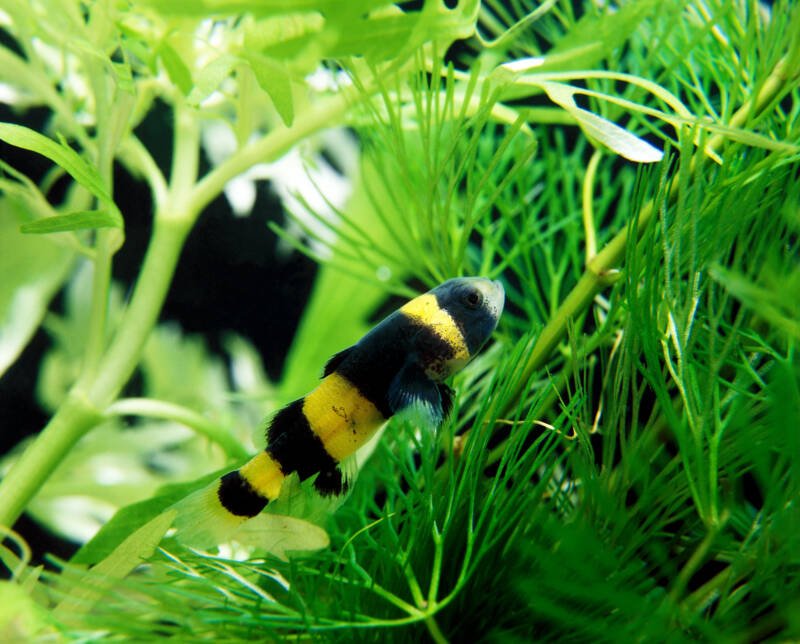
Bumblebee gobies like to do a little bit of excavation. It’s nothing like you’ll see with cichlid species, but you still want to keep them safe. As such, sand substrate works better than gravel. It also helps replicate their natural habitat.
Even if you decide to keep a single-species tank, you want to provide hiding places.
Bumblebees are shy by nature. They appreciate rocks, driftwood, caves, and pieces of ceramic to dart into when they’re feeling vulnerable.
Live plants get tricky when you’re dealing with a brackish species. You have to find species that don’t mind a bit of salt in their diet.
Java fern doesn’t seem to mind anything. Or you can opt for plastic plants, which will hold up under any conditions.
Bumblebee Gobies in Communities
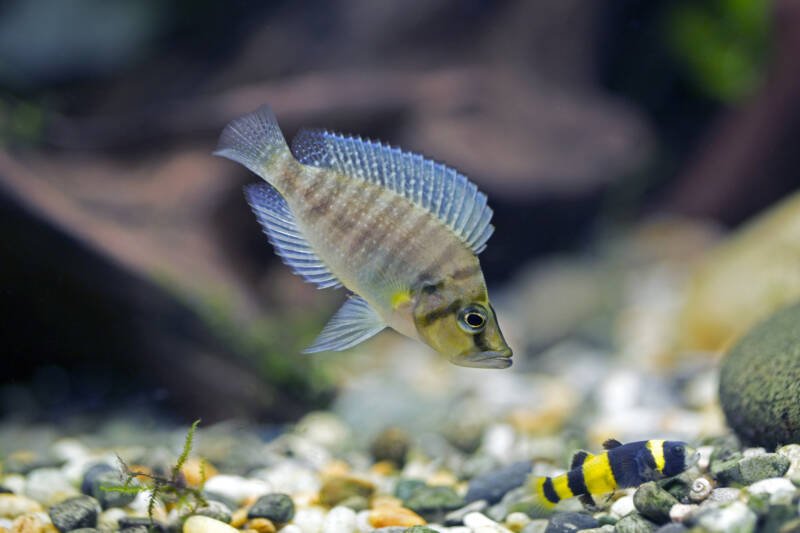
Unfortunately, bumblebee gobies require brackish water conditions. This makes them difficult to add to most colorful aquarium collections.
They’re also the perfect size – for snacking. Does that mean you CAN’T add them into a community? Not quite.
Tank Mates
Most aquarists establish bumblebee gobies in single-species aquariums.
Of course, there are multiple species within the Brachygobius genus. And they all look close enough that most people have trouble telling them apart. So you can always create a bumblebee community.
If you’d rather go for something more dynamic, bumblebees work well with several species of shrimp, tolerating well the brackish water.
You need to avoid the smaller species (such as cherry shrimp), though. Tiny invertebrates, including snails (nerite snails, MTS, or lava snails) have a habit of ending up on the menu.
But if you can pin down brackish-tolerant fish that are the same size and peaceful, bumblebee gobies do well.
You’re better off looking for fish that prefer the middle and upper reaches of the water column. Then your gobies won’t feel crowded.
Incompatible Species
Mollies and platies both tolerate brackish water without a problem.
Unfortunately, they’re also on the large side. They may not bother with the bottom of the tank, but they’re imposing enough to force bumblebees into hiding all of the time.
With that kind of stress hanging overhead all the time (literally), you’re better off skipping the two species.
They’re not particularly aggressive, but your gobies will end up too nervous to eat or venture out of their chosen hiding places.
Food and Diet
Bumblebee gobies order from the carnivore side of the menu. And, ordinarily, that would make them a cinch to feed.
But these little fish are some of the pickiest eaters in the aquatic world. It’s one of the things that makes them so difficult to manage.
If their food isn’t moving, most bumblebees won’t eat. That means commercial foods aren’t an option.
And you can’t even get away with frozen proteins. Nope, you have to reach for live foods:
- Blackworms
- Bloodworms
- Brine shrimp
- Convict cichlid fry
- Daphnia
- Mosquito larvae
- Tubifex worms.
Breeding your Bumblebee Gobies: Mimic the Monsoon
Bumblebee gobies reach sexual maturity around one year of age. And as long as you’re ready to juggle a little “water play,” you can breed them without too much trouble.
All you need to do is replicate the monsoon conditions they’d find in the wild.
Sexing: Male or Female?
As you find with a lot of colorful fish, you sort male and female bumblebee by color.
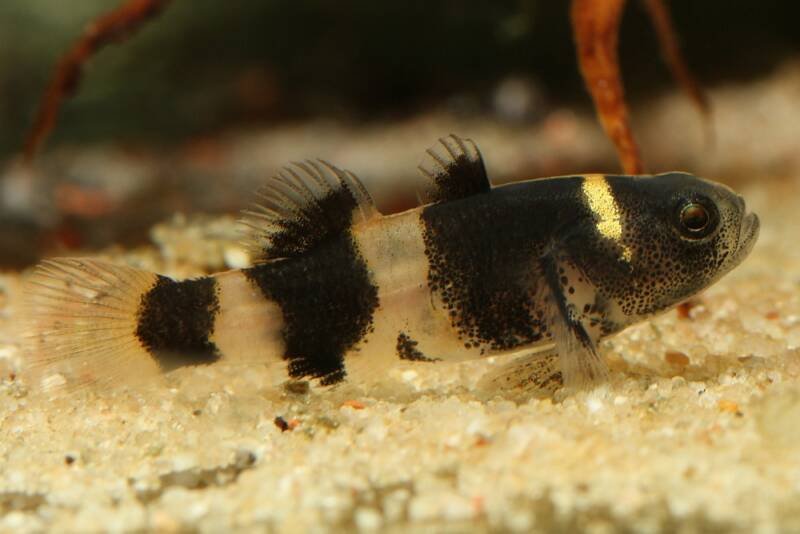
Males have more vibrant yellow shades to their scales. They also come in with a slighter profile, particularly when the females are full of eggs.
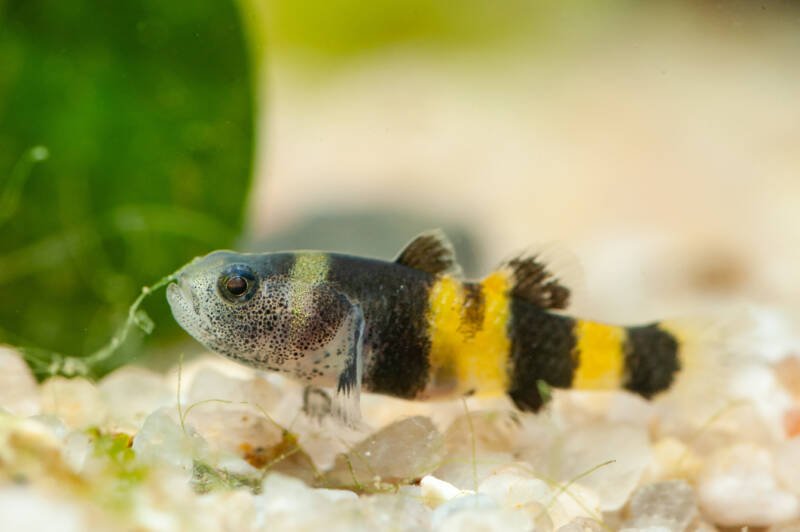
Father Knows Best
When you’re ready to breed your bumblebees, step up their protein.
You also want to add a little more freshwater to the tank. This simulates the rush of rainwater to the native regions.
You can also add a SMALL air stone to boost the oxygen (don’t overdo it).
If your females plump up, you know you’re on the right track. They can lay up to 200 eggs at a time, and they’ll look for hiding places around the tank.
You should already have those in place. If you’re using a separate breeding tank, ceramic tubes work well.
The female should come OUT of the tank, but the male needs to stay IN. He guards the eggs.
For a week, he’ll stand watch over the hiding place. Of course, once the fry hatch, he needs to get removed so he doesn’t eat them.
It takes the fry a week to finish absorbing their yolk sac and start swimming. Then you can introduce infusoria.
Bumblebee fry aren’t the fastest-growing. It takes an entire month for them to reach just 1cm! And it’ll be two months before they develop those bumblebee colors.
Health and Diseases
Stress in ANY fish can lead to an early death sentence. And one of the most stress-related diseases in the aquarium field is ich. The parasite latches on to any fish that’s struggling with water conditions.
This is why bumblebee gobies often develop ich. If you forget to ask about your breeder’s salinity level, you may introduce your fish to an unsuitable environment.
The same can result if you fail to keep up with regular water testing.
Once ich enters a bumblebee tank, it quickly spreads throughout the school. You need to move any infected fish to quarantine as soon as you notice signs.
Over-the-counter medication IS effective, but if you don’t also treat the underlying problem, it won’t solve anything.
Bumblebee Gobies: Are They for You?
Depending on your source, you’ll find bumblebee gobies for anywhere between $4-$15.
The low cost is one of the most appealing things about these colorful fish. This is how novice aquarists often get themselves into trouble.
There ARE species that occur strictly in freshwater. For instance, true freshwater bumblebee goby (Brachygobius xanthomelas) doesn’t need any salt added to its tank to remain happy and healthy. But as the species looks the same as any other in the genus, a glance won’t tell you which you have.
You MUST speak with your breeder before you bring one of these gobies into your aquarium.
Water conditions are so critical to their health. If you shock their system, you may never get to experience the challenge of getting them to eat!
Bottom-Dwelling and Brackish
Bumblebee gobies look stunning. They have bright stripes of black and yellow that stand out along the substrate.
And the challenge of managing a brackish tank calls to many people. But if you don’t prepare, these fish may prove too much to handle. Preparation is key.
Have you kept bumblebee gobies? What salinities have worked best for you?
Do they prefer certain diet items?
Let us know your questions and stories here!